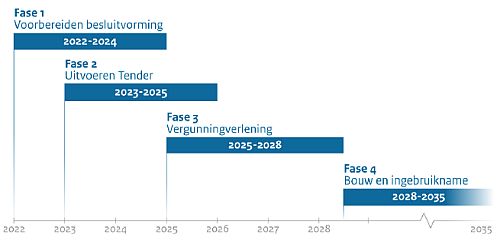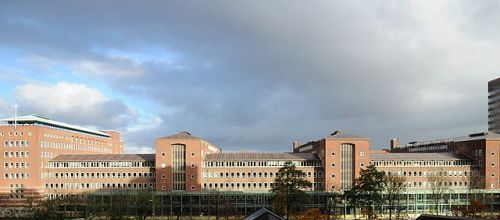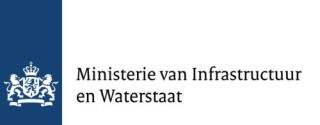Topics:
Separation promotion and protection
In the Netherlands there is a distinct separation between the responsibility for the policy on energy supply and the policy on the safe use of nuclear power. Energy supply is a topic for the ministry of Economic Affairs and Climate (Dutch: ministerie van Economische zaken en Klimaat, EZK). The ministry of Infrastructure and water management (Infrastructuur en Waterstaat, IenW) is responsible for policies and regulations on nuclear safety and radiotion protection. It has a dedicated regulatory body, the 'Autoriteit voor Nucleaire Veiligheid en Stralingsbescherming' (ANVS).
Policy on Energy Supply
Dutch energy policy focuses on energy transition, i.e. reducing the share of fossil fuels in energy supply. Today, in addition to wind and solar, this includes nuclear energy. Efforts are underway to enable the expansion of nuclear energy in the Netherlands. A group has been set up within the Ministry of Economic Affairs & Climate (EZK) to work on all practical aspects.
An ambitious schedule has been drawn up, the 'roadmap', see below. In it, several trajectories are partly implemented in parallel to save time. In his letter of 9 December 2022, the EZK minister acknowledges that there are risks attached to this, but they are justified. Ultimately, this should generate around 3,000 MW of electric nuclear power capacity. It is also being investigated whether the existing nuclear power plant at Borssele (485 MW) can stay open longer, i.e. beyond its planned closure date in December 2033.

'Routekaart' or Schedule for new build NPPs

A building of the Ministry of EZK
Policy on nuclear safety
In the Dutch policy regarding nuclear power, safety has the highest priority. This complies with European Directives and the guidance of the Atomic Energy Agency of the UN, the IAEA. And has been laid down in Dutch regulation. The ministry of IenW is responsible for the maintenance and development of policies and regulations regarding nuclear safety and radiation protection.

Logo of the ministry of IenW
Regulation
The most important law for regulating the safety of applications of nuclear technology is the so-called Nuclear Energy Act, the Kew. The Kew is also important for protecting against the effects of applications of ionising radiation, such as use of röntent devices, radioactive sources for measurements and use of substances containing natural radioactivity.
The Kew is not the only piece of legislation; there are many other ('lower') regulations. Altogether a complex whole, which you need to be well versed in if you apply for a permit or (as a civil servant) have to assess a permit application.
Licensing, oversight and enforcement
These are tasks of the Nuclear Safety and Radiation Protection Authority, the ANVS. It is an independent authority for such matters in the Netherlands. The ANVS is funded by the Ministry of Infrastructure and Water Management (IenW).
Safety analyses and licensing application documents
With every licence application, the applicant (the future licence holder) has to demonstrate that his nuclear power plant will comply with all regulations, not only those in the Nuclear Energy Act, but also with all other environmental laws. Doing this properly requires a lot of experience, great knowledge of the Dutch regulations, experience with how supporting documents should be put together and written to enable a proper assessment by the ANVS.
For a foreign supplier, this is difficult. It will supply a lot of technical documentation to its client, but the client (also the licence applicant) will still have to make a whole. A Technical Support Organisation with expertise in Dutch nuclear licences and knowledge of the details of nuclear technology can help. Often, not 1 party will be hired, but several parties, each of which can cover certain aspects, also in order to deal with non-nuclear environmental issues..
Regarding support on nuclear licensing, safety analysis, design evaluation, operational support et cetera, in the Netherlands there is only one suitable consultancy firm, the Nuclear Research & consultancy Group (NRG) with facilities and offices in Arnhem and Petten. Also refer to the pages of their consultancy branch, named 'Ensuring nuclear performance'. For decades they have been the supporting consultancy for all major nuclear licence holders in the Netherlands, while also supporting foreign clients and being involved in international certification of new reactor designs.

Logo of the consultancy-branch of the Nuclear Research and consultancy Group (NRG). Recently NRG merged with the project organisation of the PALLAS-reactor, creating a new NRG-PALLAS entity, with very recent experience with contracting a reactor, planning, engineering and licensing in the Nethelands.
Reactor-certifications
EUR certification
There are several initiatives, which improve the licensability of reactor types. A very important one is the 'European Utility Requirements for LWR Nuclear Power Plants' (EUR). This 'set of requirements' defines the safety requirements a reactor design should meet to be 'licensable' in European countries. These specifications are contained in the 'EUR Specification Document, which consists of several volumes (Volumes 1, 2 & 4). There is also a Volume 3, which describes per approved reactor type, how that type meets the requirements.
The EUR requirements were drawn up by major electricity producers and a number of advisory organisations, which united in 1991 to form the 'EUR Organisation'. From the Netherlands, NRG, the Nuclear Research and consultancy Group, is a member of that EUR organisation (and is even a co-founder).
Designers of new types of nuclear power plants/reactors can submit their design to the EUR Organisation in a form laid down in the 'EUR Specification Document' mentioned above. The EUR Organisation then does a review. This is a lengthy process in which the designers adjust their design according to comments. The assessing experts (from NRG and others) have a deep understanding of the safety features of nuclear power plants and requirements they must meet.
When the assessment of a reactor design is complete, it produces a subset of 'Volume 3' of the EUR Specification Document. The reactor design is then in effect EUR-certified.
GDA process in the UK
In the UK, they have the 'Generic Design Assessment (GDA) of new nuclear power stations'. This is carried out by the licensing authority, the 'ONR Office for Nuclear Regulation' and 'the Environment Agency'. The GDA is a kind of preliminary study in which the government assesses a design for its safety features. This does not constitute a licence for construction, but a kind of type approval. For construction, more is needed such as a 'Site licence' with associated site-specific assessment, an environmental licence in which non-nuclear items are also considered, and some other permits.
A completed GDA process provides a lot of information, which is also useful for assessors in the Netherlands. But because of differences between countries, it is not sufficient for a complete assessment. Also, a different reactor-variant may just be offered in the Netherlands than was done in the UK, which then requires additional study.
Design Certification in the USA
In the US, the US Nuclear Regulatory Commission (US NRC) is the Competent Authority for nuclear power plants. There is the Design Certification for reactor types, similar to the GDA in the UK. Several models have been 'certified' and several certification processes are ongoing. There is also much to learn from these certifications for Dutch practice, although the regulations in the US differ considerably from those in the Netherlands.
back to top